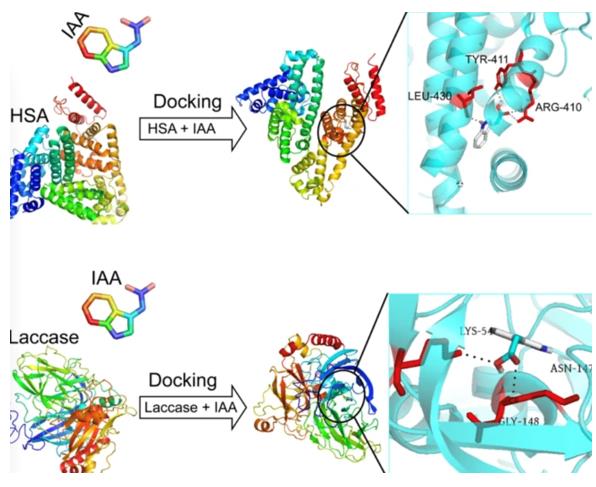Enzyme Docking Studies are a fundamental and indispensable part of modern biochemistry and computational biology. They provide a powerful tool that allows researchers to predict how small molecules, such as substrates or drugs, interact with a protein of interest. This process is done virtually in a lab and helps researchers visualize how these molecules fit together. By understanding these interactions, scientists can gain valuable insights that can lead to the development of new drugs or enhance the understanding of complex biological pathways.
 Molecular docking study of biocompatible enzyme interactions (Sana D., et al., 2021)
Molecular docking study of biocompatible enzyme interactions (Sana D., et al., 2021)
Technical Route
The technical route of Enzyme Docking Studies is a complex and intricate process that involves a series of detailed steps:
| Step |
Description |
| Protein preparation |
In this initial step, the protein of interest is meticulously prepared. This preparation process involves assigning the correct charges to the protein. Additionally, hydrogens are added to the protein to ensure its stability and functionality. Furthermore, the protein geometry is optimized, which is a crucial step to ensure the accuracy of the subsequent processes. |
| Ligand preparation |
The preparation of the ligand or small molecule is conducted in a similar manner to the protein. It is of pivotal importance to consider the various forms a ligand can take because these different forms can substantially influence the results of the docking process. |
| Docking |
Once the protein and ligand are adequately prepared, they are then docked together. During this critical stage, various software programs are employed to determine the most suitable way for the ligand to fit into the protein. This step is fundamental as it sets the groundwork for the interaction between the protein and the ligand. |
| Visualization and analysis |
Following the docking stage, the results are then visualized and meticulously analyzed. This step is vital for researchers as it allows them to determine whether the predicted interaction between the protein and ligand is feasible. Moreover, this step allows researchers to gain a deeper understanding of how the ligand interacts with the protein, providing valuable insights that could contribute to further scientific exploration. |
Service Process
Our company proudly provides an extensive range of services focused on Enzyme Docking Studies. Our services encompass:
- Initial Consultation: We initiate our process by deeply understanding the specific needs and objectives of our clients. This allows us to customize our comprehensive range of services to best align with their unique requirements, ensuring that every aspect of our work is designed to meet their specific needs.
- Protein and Ligand Preparation: Following the initial consultation, our dedicated team of highly skilled professionals prepares the protein and ligand for the subsequent docking process. This preparation is crucial in ensuring the success of the docking studies.
- Performing Docking Studies: Once the protein and ligand are prepared, we employ cutting-edge software and tools to perform the detailed docking studies. Our use of leading-edge technology ensures that our studies are as precise and accurate as possible.
- Analysis and Visualization: After conducting the docking studies, we don't stop there. We undertake a thorough analysis of the results and provide our clients with detailed visualizations. This helps our clients gain a more in-depth understanding of the complex interactions between their protein and ligand of interest.
- Delivery of the Final Report: Our commitment to our clients extends beyond the studies themselves. We deliver a comprehensive final report that encapsulates all the findings from the study, providing a clear and concise summary of our work. This report serves as a valuable tool for our clients to reference in their future work.
We're here to assist you. If you have any questions, need more information, or would like to discuss a potential project, please don't hesitate to contact us. Our team is always eager to help and share our expertise.
Applications
We serve a diverse range of application areas including but not limited to pharmaceutical research, agricultural research, and academic research. No matter what your research needs are, we are committed to providing the highest quality Enzyme Docking Studies to help you achieve your goals.
| Application |
Description |
| Drug Discovery |
Enzyme docking studies are extensively utilized in drug discovery to identify potential small molecule inhibitors or activators by predicting the binding modes and affinities of ligands to target enzymes. This aids in rational drug design and optimization processes. |
| Enzyme Engineering |
Enzyme docking plays a crucial role in enzyme engineering by predicting and analyzing the binding interactions between enzymes and substrates or inhibitors. By understanding the structural basis of enzyme-substrate recognition and catalysis, docking studies guide the rational design of enzyme variants with improved activity, specificity, and stability for various biotechnological applications. |
| Structural Biology |
Enzyme docking studies are utilized in structural biology to elucidate the molecular mechanisms underlying enzyme function, substrate recognition, and catalytic activity by predicting the binding conformations of ligands and substrates within the enzyme's active site. |
| Protein-Protein Interactions |
Enzyme docking extends to the study of protein-protein interactions, where it is used to predict the binding interfaces and affinity of protein complexes involved in signaling pathways, enzymatic cascades, and regulatory networks. By simulating the docking process between interacting proteins, docking studies provide insights into the molecular mechanisms underlying protein complex formation and function, facilitating the elucidation of cellular processes and the design of therapeutic interventions targeting protein-protein interactions. |
| Substrate Specificity Analysis |
Enzyme docking aids in elucidating substrate specificity and recognition mechanisms by predicting the binding modes of substrates and analogs within enzyme active sites. By analyzing the interactions between enzymes and substrates at the atomic level, docking studies reveal key residues and structural features governing substrate binding and catalysis, guiding experimental studies and rational engineering efforts to modulate enzyme specificity for biocatalytic applications and metabolic engineering. |
| Agricultural Biotechnology |
In agricultural biotechnology, enzyme docking studies are employed to understand the mechanisms of enzyme-substrate interactions, aiding in the development of enzymes for various applications such as biofuel production, crop protection, and soil remediation. |
FAQs
For further details regarding our Enzyme Docking Studies, please consult our FAQ section. We've curated this section to address common inquiries and offer comprehensive explanations, aiding in your understanding of our methodologies.
Q: What software is typically used in Enzyme Docking Studies?
A: A variety of software is used in Enzyme Docking Studies, such as AutoDock, DOCK, and Glide. The choice of software largely depends on the specific needs and goals of the study.
Q: What are the constraints of Enzyme Docking Studies?
A: Despite their usefulness, Enzyme Docking Studies have certain limitations. These include possible inaccuracies in the protein and ligand models used and in the computational algorithms. Also, these studies can't account for dynamic changes in protein structure, which might restrict their effectiveness.
Q: How long does an Enzyme Docking Study usually take?
A: The time frame for an Enzyme Docking Study can vary greatly, largely depending on the complexity of the protein and ligand involved. However, it usually takes from a few days to a few weeks.
Q: Can docking studies provide predictions about binding affinities?
A: Yes, docking studies can estimate binding affinities. However, it's crucial to validate these estimates with experimental data for accuracy.
Q: How precise are the results from docking studies?
A: The accuracy of docking studies can vary, depending on factors like the quality of the protein and ligand models and the docking algorithm used in the study.
Q: Are docking studies suitable for all types of proteins?
A: Docking studies are most effective for proteins with well-defined binding sites. They may be less effective for proteins with flexible or undefined binding sites.
Q: Can I supply my own protein and ligand structures for the study?
A: Yes, in many cases you can provide your own protein and ligand structures for enzyme docking studies. Typically, you will need to provide us with the 3D structure of the protein (enzyme) and ligand. To ensure we best meet your requirements, please contact us directly.
Q: What kind of results can be expected from a docking study?
A: A docking study typically provides a detailed report. This report will include the predicted interactions between the protein and the ligand, potential binding sites, and the estimated binding affinity.

































 Molecular docking study of biocompatible enzyme interactions (Sana D., et al., 2021)
Molecular docking study of biocompatible enzyme interactions (Sana D., et al., 2021)